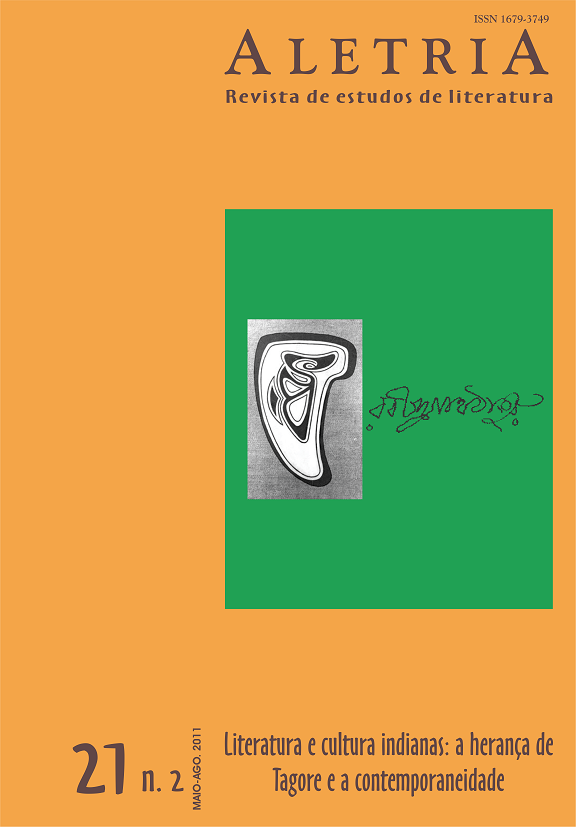The Tiger in the Year of the Dragon
DOI:
https://doi.org/10.17851/2317-2096.21.2.157-170Keywords:
Cultural studies, tiger, Chinese culture, dragonAbstract
This paper describes the symbolic representation of the tiger in the Chinese culture taking into account anthropological and literary approaches to demonstrate the importance of the feline with a status similar to the dragon, in this cultural model.
This paper describes the symbolic representation of the tiger in the Chinese culture taking into account anthropological and literary approaches to demonstrate the importance of the feline with a status similar to the dragon, in this cultural model.
Downloads
References
CAO, Zhenfeng. Shén hu& zhèn xié [O tigre divino retém o mal]. Beijing: Shehui kexue
wenxian, 1998.
CAPPARELLI, Sérgio; SCHMALTZ, Márcia. 50 fábulas da China fabulosa. Porto Alegre:
L&PM, 2007.
CHEN, Qinghao. Zho#ngguó mínjia#n gùshì quánjí [Contos populares chineses completos].
Taipei: Yuanliu, 1989.
HAN, Fei. Hán Fe#izi& [O Príncipe Han Fei]. Disponível em: http://ctext.org/hanfeizi/zh.
Acesso em: 01 de fevereiro de 2012.
HE, Xingliang. Túténg wénhuà yu& rénlèi zhu# wénhuà de qi&yuán [Cultura do totem e a
origem da cultura humana]. Beijing: Zhongguo Wenlian, 1991.
HOLLAND, Dorothy; QUINN, Naomi. Cultural Models in Language and Thought.
Cambridge: CUP, 1987.
LI Fang et al. Tàipíng Gua&ngjì [Registros de Taiping]. Disponível em: http://
www.shuku.net:8080/novels/classic/taipinggj/tpgj.html. Acesso em: 30 de janeiro de 2012.
Lijì [O livro dos ritos]. Disponível em: http://ctext.org/liji/tan-gong-ii/zhs#n9720. Acesso
em: 02 de fevereiro de 2012.
LIU, An. Huáinánzi& [O livro do príncipe de Huainan]. 2. ed. Taipei: Shibao wenhua,
AA
A LETRI A - v. 21 - n. 2 - maio-ago. - 2 0 11
LIU, Xiang. Zhànguò Cè [Estratégias dos reinos combatentes]. Disponível em: http://
ctext.org/zhan-guo-ce/zh. Acesso em: 31 de janeiro de 2012.
SCHMALTZ, Márcia. Metáfora conceptual de tempo em fábula chinesa. Organon, Porto
Alegre, UFRGS, n. 43, v. 2, p. 35-52, 2007.
SCHMALTZ, Janete; SCHMALTZ, Márcia. Histórias da mitologia chinesa. São Paulo:
Livro Aberto/Xerox, 1999.
SCHMALTZ, Márcia; Sérgio Capparelli. Contos sobrenaturais chineses. Porto Alegre:
L&PM, 2010.
Sha#nha&iji#ng [O livro da natureza]. Haikou: Nanhai, 2007.
SHI, Nai’an; LUO, Guanzhu (?1300-?1400). Shui&hu& Zhuàn [Na ribanceira somos todos
irmãos]. Beijing: Zhongguo wenxue, 1997, 931 p.
SIMA, Qian. Shi&jì [Registros da história]. Taipei: Dingwen, 1997.
SUN, Wu. Su#nzi& bi#ngfa& [A arte da guerra]. Disponível em: http://ctext.org/art-of-war/
zh. Acesso em: 30 de janeiro de 2012.
Yìji#ng [O livro das mutações]. Disponível em: http://ctext.org/book-of-changes/yi-jing/
zhs. Acesso em: 05 de fevereiro de 2012.
WANG, Chong. Lùn héng [Sobre a balança]. Wuhan: Universidade Politécnica de
Wuhan, 2001.
WANG, Fenling. Zho#ngguó hu& wénhuà yánjiù [Uma investigação da cultura do tigre na
China]. Changchun: Universidade Normal do Nordeste, 1998.
Downloads
Published
How to Cite
Issue
Section
License
Copyright (c) 2011 Marcia Schmaltz (Autor)

This work is licensed under a Creative Commons Attribution 4.0 International License.
Authors who publish with this journal agree to the following terms:Authors retain copyright and grant the journal right of first publication with the work simultaneously licensed under a Creative Commons Attribution Non-Commercial No Derivatives License that allows others to share the work with an acknowledgement of the work's authorship and initial publication in this journal.Authors are able to enter into separate, additional contractual arrangements for the non-exclusive distribution of the journal's published version of the work (e.g., post it to an institutional repository or publish it in a book), with an acknowledgement of its initial publication in this journal.Authors are permitted and encouraged to post their work online (e.g., in institutional repositories or on their website) prior to and during the submission process, as it can lead to productive exchanges, as well as earlier and greater citation of published work (See The Effect of Open Access).





